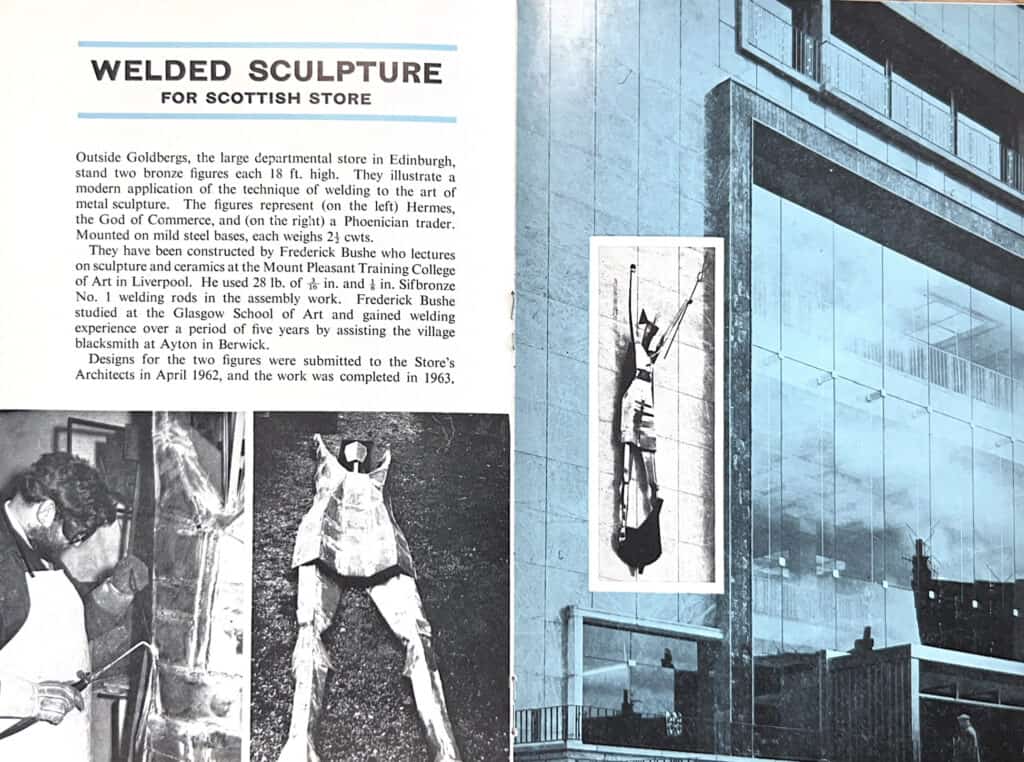Products Used in the Construction of the Sculptures:
- Sifbronze No. 1 Welding Rods: Used extensively in welding bronze figures, providing the necessary strength and flexibility to shape large sculptures.
- Mild Steel Base: Each bronze sculpture was mounted on a mild steel base, ensuring stability and durability in the outdoor environment.
In the bustling streets of Edinburgh, outside the iconic Goldberg’s Department Store, two towering bronze figures stand, each reaching an impressive height of 18 feet. These monumental sculptures, representing Hermes, the God of Commerce, and a Phoenician Trader, were designed to embody the spirit of trade and commerce, symbolising the store’s rich history and global connections. More than just symbols, these figures also celebrate modern welding techniques applied to the art of sculpture.
The project, completed in 1963, was the brainchild of Frederick Bushe, a talented sculptor and lecturer in sculpture and ceramics at Mount Pleasant Training College of Art in Liverpool. His expertise in metalworking and sculpture, honed over five years of hands-on experience with a village blacksmith in Ayton, Berwick, enabled him to tackle this monumental task with precision and creativity.

Bushe’s process began with detailed designs submitted to the store’s architects in April 1962. Once approved, Bushe turned to his welding torch, using Sifbronze No. 1 welding rods to assemble the bronze pieces. These welding rods were specifically chosen for their ability to fuse bronze seamlessly, providing strength and flexibility, which is crucial for creating large-scale outdoor sculptures that must withstand the elements.
The figures weighing 2 ½ cwt were constructed from bronze and mounted on mild steel bases to ensure their stability. Bushe used 28 lbs of ⅛ inch and ⅛ inch Sifbronze No. 1 rods, skilfully welding each piece to create the towering forms of Hermes and the Phoenician Trader. His experience in sculpture and welding allowed him to blend artistry with craftsmanship, ensuring that the figures were visually striking and structurally sound.
Each figure represents a different aspect of commerce: Hermes, the messenger god and protector of merchants, is a tribute to the bustling trade that sustained Goldberg’s Department Store, while the Phoenician Trader symbolises the ancient maritime trade routes that connected civilisations. With their detailed forms and imposing presence, the sculptures quickly became a landmark in Edinburgh, drawing the attention of passersby and customers alike.
For Bushe, the project was a chance to push the boundaries of welded sculpture. His time studying at the Glasgow School of Art and his practical experience working with a blacksmith gave him the skills necessary to take on such an ambitious project. The use of Sifbronze rods was crucial to his success, allowing him to work with bronze in a way that few sculptors at the time could manage.
The final sculptures, completed in 1963, still stand today as a testament to both Bushe’s artistic vision and the power of welding in creating lasting works of public art. By merging traditional sculpture techniques with modern welding technology, Bushe was able to create figures that are beautiful, durable, and capable of withstanding the harsh Scottish weather for decades to come.
Through his use of Sifbronze No. 1 rods and his deep understanding of art and metalwork, Frederick Bushe created something genuinely remarkable—two sculptures that stand as both art and symbol, reflecting the history and future of commerce in Edinburgh.
Remembering Edinburgh’s iconic department store Goldbergs with funfair and roof garden https://www.edinburghlive.co.uk/news/history/remembering-edinburghs-iconic-department-store-22467282
